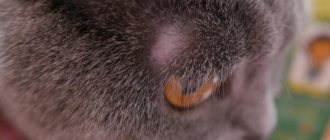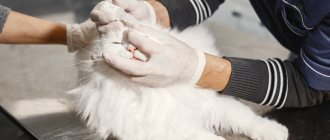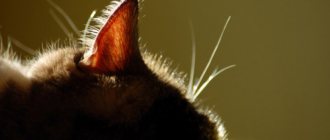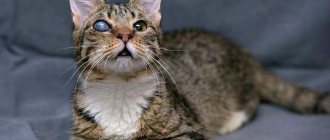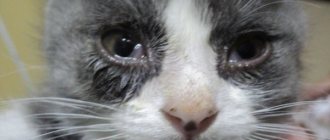When owners notice that a cat’s ears are going bald, they should pay attention to the animal’s diet, since a similar problem is possible due to a lack of vitamins and microelements in the cat’s body. Baldness around the ears may also indicate endocrine and other serious diseases that require urgent medical treatment. As soon as a kitten has areas without hair near its ears, its legs become bald, and other symptoms of a sore appear, it is worth contacting a veterinary clinic for examinations and selection of therapy.
The appearance of receding hairline: reasons
The area of the skin where hair has fallen out is called a receding hairline; such a change is not normal and can appear for various reasons, including:
- Allergic reaction to food, medications.
Allergies to food (industrial feed, lamb, cereals), medications often develop in cats. Signs of the pathological condition: baldness of the skin near the ears and eyes, on the stomach, constant itching, redness of the bald areas.
- Endocrine alopecia.
Hair loss may indicate hormonal imbalances in the animal’s body, indicating the development of diseases such as: pathologies of the thyroid gland, diabetes mellitus, malfunction of the adrenal glands, malfunctions of the internal glands. Additional signs of hormonal imbalance are: excessive drinking of water, frequent urination, sudden weight loss.
- Parasites.
Hair loss can occur if the cat is infected with ringworm. Infection occurs through contact with a carrier of parasites; the disease may not manifest itself for a long time. Subcutaneous mites begin to actively develop if the pet’s immunity is weakened.
Additional symptoms: flaky skin, the formation of bleeding wounds, ulcers above the eyes. Fleas can also cause baldness, biting parasites bother the animal, the cat begins to intensively scratch the skin, as a result of which the hair roots become weak and the hair falls out.
- Scabies, lichen.
Be sure to read:
Why does a cat constantly scratch its chin: what kind of disease is it?
Bald spots may indicate the development of infectious diseases, such as lichen or scabies.
Why is there a problem?
In veterinary medicine, hair loss in the area of the ears and other parts of the cat’s body is called alopecia. The following factors can influence the occurrence of bald spots above the eyes:
- Allergic reaction. The source of allergies are toxic substances, dry food and some food products, medications and more. When your cat is exposed to allergens, his bald spots increase and severe itching and irritation occur.
- Otodectosis or scabies. The disease, which causes hair loss on the head and in the ears, is caused by the activity of ear mites. If not treated in a timely manner, the disease leads to otitis media.
- Ringworm and other fungal infections. The fungus poses a health hazard to cats, especially kittens, and can lead to baldness. It is worth contacting a veterinarian as soon as your pet’s fur begins to fall out and redness occurs.
- Viral diseases. Against the background of the disease, symmetrical alopecia and other unpleasant symptoms may occur. Bald spots due to viral diseases are visible not only in the ears, but also in the area of the hind legs and other parts of the body.
- Hormonal imbalances. A pregnant cat faces similar problems, and baldness can also occur due to hyper- or hypothyroidism.
- Hereditary factor. Baldness can be caused by gene mutations that are inherited.
Veterinarians do not recommend exposing pets to severe stress, since against this background the animal may refuse to eat and become restless, including the cat becoming bald in the ear area.
Causes of baldness in kittens
The problem of baldness in kittens may be related to their diet, so it is worth balancing it and adding vitamins.
If a young representative of the cat family has bald ears, this does not always indicate a pathological process. Owners should pay attention to the kitten's nutrition. It is not recommended to suddenly change one food to another or try to somehow diversify the animal’s diet. If the problem lies in an unbalanced diet, then it is worth giving the animal vitamins. Baldness on the hind legs, ears and other parts of the body can also be a consequence of insufficient function of the immune system.
How to distinguish normality from pathology?
Baldness of skin areas is not always caused by pathological reasons. In some cases, hair loss occurs in cats that have recently given birth to kittens. The problem arises due to an unbalanced diet. A nursing mother needs increased nutrition and vitamin intake.
In animals of smooth-haired breeds, bald spots can occur as a result of regular licking of the fur, due to genetic predisposition.
Hair loss may indicate nervous strain that has arisen in the cat as a result of moving or having a new pet. Such situations are stressful for the pet; treatment is by taking sedatives.
Vitamin deficiency can be another reason for hair loss.
Preventive measures
Preventing skin disease such as alopecia is not difficult. To do this, you must adhere to the following measures:
- Observe hygiene rules. The owner must remember to inspect the cat’s fur (especially if he is often outdoors) for ticks and other parasites and deal with them in a timely manner;
- Provide the animal with a balanced diet. The cat's diet should contain vitamins and other useful microelements;
- Carry out routine vaccinations for your pet;
- Visit the veterinarian periodically. During the examination, a specialist can identify possible pathologies;
There is no need to “sound the alarm” if your beloved cat has bald patches on his skin. This phenomenon is not uncommon for most cats. If you find the cause of the pathology in a timely manner and carry out treatment, it is easy to return your pet to vigor and health.
I graduated from the National State Agricultural Academy and have been working as a veterinarian for 8 years.
In my free time, I write articles about the diagnosis and treatment of cats.
Feel free to ask questions in the comments, I will try to answer everything.
Quite often, baldness around the eyes of a cat can be associated with seasonal shedding, which lasts 1-2 weeks. If this process is prolonged or accompanying symptoms appear, then the option of molting disappears and you should think about possible problems with nutrition (incorrectly selected food often causes food allergies), parasites or bacterial infection.
Bald patches near the ears
The development of characteristic bald spots near the ears of an animal (periacular alopecia) occurs in a cat for the same reasons as hair loss above the eyes.
To make a diagnosis and prescribe treatment, your pet should be taken to a veterinary clinic, where the doctor:
- will conduct a visual inspection,
- will prescribe a series of tests,
- take scrapings from the skin,
- Based on the data obtained, he will prescribe treatment.
Diagnosis of the disease
Only an experienced veterinarian can determine why bald patches appear above the eyes and in the ear area in cats. He carries out the following diagnostic measures:
- analyzes the pet's medical history;
- conducts a thorough examination of the cat;
- carries out microbiological examination of animal hair roots;
- prescribes specific and general blood tests;
- takes a scraping of the epidermis;
- To identify signs of neoplasms, the veterinarian prescribes an ultrasound or x-ray.
The appearance of bald patches: what to do
A cat owner who notices the appearance of bald spots should not self-medicate. The pet should be taken to a veterinarian to determine the cause of the illness. The doctor will conduct an examination and prescribe adequate treatment.
Prevention measures:
- feeding with quality feed,
- regular hygiene procedures,
- timely vaccination of the animal,
- taking vitamin complexes,
- regular checkups with a veterinarian.
Be sure to read:
What to do if a cat licks its fur to bald spots and wounds, what is overgrooming
How to treat alopecia in cats
The nature of the treatment depends on the cause that provoked the appearance of local bald patches. If the disease is allergic, it is necessary to isolate the animal from exposure to allergens. “The veterinarian should prescribe immunostimulants and antiallergic drugs to the cat.” In addition, the animal must adhere to a special hypoallergenic diet.
If alopecia is caused by parasites, the animal is recommended to use special sprays, gels, and ointments that have antiparasitic properties. In addition, the cat should additionally take vitamin complexes to stimulate immune function.
Abscess and pyoderma, which also provoke alopecia, are treated by treating the skin with systemic and external antibiotics, as well as antiseptics.
Taking hormonal medications is indicated for endocrine alopecia, but if the disease is of a psychogenic nature, the cat is prescribed sedatives.
Review of possible pathologies
If a cat develops bald patches above the eyes due to scratching, then the cause must be sought in pathology, which can cause severe itching in the area of the nose, forehead, temples and organs of vision. First of all, exclude the option of parasites, whose bites can cause severe irritation, especially in allergic breeds. And then, based on the existing symptoms and diagnostic measures carried out, they sort out the possible causes:
- Fungus. Due to ringworm, a cat may develop bald patches above the eyes, ears, near the tail and limbs. The lesions look like bald spots, inside of which there are wet areas of skin that are predominantly red. Itching is present in almost all cases; because of it, the animal may develop large scratches, often complicated by secondary infection. Most cases of fungal infection occur in dermatophytosis (namely Microsporum Canis). The diagnosis can only be confirmed in laboratory conditions using a microscope and a Wood's lamp. In controversial or severe cases, culture may be required, which is considered the most informative in determining the pathogen. Based on the results of the analysis, drugs are selected that will have a detrimental effect on fungal spores. Most often the choice falls on Itraconazole, Terbinafine, Nizoral. At the same time, the room where the pet lives is disinfected. To do this, you can use special chlorine-containing substances that are added to water for washing floors and other surfaces. It should be noted that dermatophytes die at temperatures above 50 degrees, so the animal’s sleeping place can be boiled (sheet or bedding). Much attention is paid to the disinfection of carpets and rugs, since a large number of fungal spores always remain on their surface. And finally, I would like to share the opinion of foreign experts who have proven that vaccination is not effective either in the treatment of lichen or in prevention. So don’t be fooled by illiterate veterinarians.
- Injury. In the form of deep scratches from claws or bites from the teeth of other animals. It may be very itchy as it heals. This will cause your pet to scratch the affected areas with its paws. This may explain the appearance of bald patches above the eyes of a cat. Therefore, if there is any damage to the visual organs that may itch during the healing process, it is best to use a special medical cap that limits the animal’s access to the wound.
- Fleas. Because of them, bald spots on cats above the eyes do not appear so often, but this option should not be ruled out. Especially if the pet, for no apparent reason, began to itch a lot. Unscheduled treatment of the animal with one of the parasitic drugs (Stronghold, Advocate, Frontline or Advantage) 2 times every 3 weeks will help eliminate this option.
- Conjunctivitis. Inflammatory process of the mucous membranes of the eyes. It is almost always a consequence of the animal having a disease associated with the organs of vision, allergies or an infectious process. With all types of conjunctivitis, profuse lacrimation is present. Dry crusts form around the eyelids. In every second case, severe itching is noted. Therefore, if a cat has developed bald patches above the eyes after a recent injury to the cornea, the possibility of developing conjunctivitis or keratitis should be ruled out.
- Allergy. A real problem for ornamental breeds, which often suffer from improperly selected food, reactions to flea saliva, plant pollen, house dust or mold. Therefore, when bald patches appear above the eyes in British cats and Maine Coons, they consider the option of food allergies. Often changing the brand of the manufacturer or switching to hypoallergenic food brings positive results. If there is redness, peeling of the skin and severe itching, antihistamines are prescribed.
Treatment
Treatment of sores on the ears and face of a cat requires an integrated approach based on research results. Depending on the type of pathological process and the cause that caused it, the veterinarian develops an individual scheme.
Crusts and ulcers formed on the ears and face as a result of an allergic reaction should be treated by eliminating the provoking factor. So, in case of nutritional allergies caused by improper feed or products, a replacement diet is carried out. The specialist selects the food and observes the body’s reaction.
If the cause of the allergy is contact with household chemicals, it is necessary to eliminate the allergen from everyday life. As a rule, after eliminating the underlying factor of the allergy, the body copes on its own and the skin is restored.
The addition of pathogenic bacterial microflora implies the use of antibiotics. The duration of the course and the type of drug are selected by the doctor, taking into account the patient’s age, weight and body characteristics.
Treating ulcers on a cat’s face and ears is quite problematic, since the animal often licks external medications (ointments and liniments) that are applied to disinfect wounds and eliminate pathogenic microflora. During the entire course of therapy, the owner is recommended to purchase a special collar to put on the animal so that it does not reach the treated areas. If your cat feels discomfort and refuses to eat with the collar around its neck, you can remove it while eating.
The resulting sores on the skin, provoked by subcutaneous mites (sarcoptosis or demodicosis), are treated comprehensively. In addition to specific medications, therapy necessarily includes taking immunomodulating agents and vitamin complexes. This is due to the fact that with a normal level of immunity, the animal’s body is able to cope with the disease on its own.
Preventive measures
Preventing skin disease such as alopecia is not difficult. To do this, you must adhere to the following measures:
- Observe hygiene rules. The owner must remember to inspect the cat’s fur (especially if he is often outdoors) for ticks and other parasites and deal with them in a timely manner;
- Provide the animal with a balanced diet. The cat's diet should contain vitamins and other useful microelements;
- Carry out routine vaccinations for your pet;
- Visit the veterinarian periodically. During the examination, a specialist can identify possible pathologies;
There is no need to “sound the alarm” if your beloved cat has bald patches on his skin. This phenomenon is not uncommon for most cats. If you find the cause of the pathology in a timely manner and carry out treatment, it is easy to return your pet to vigor and health.
